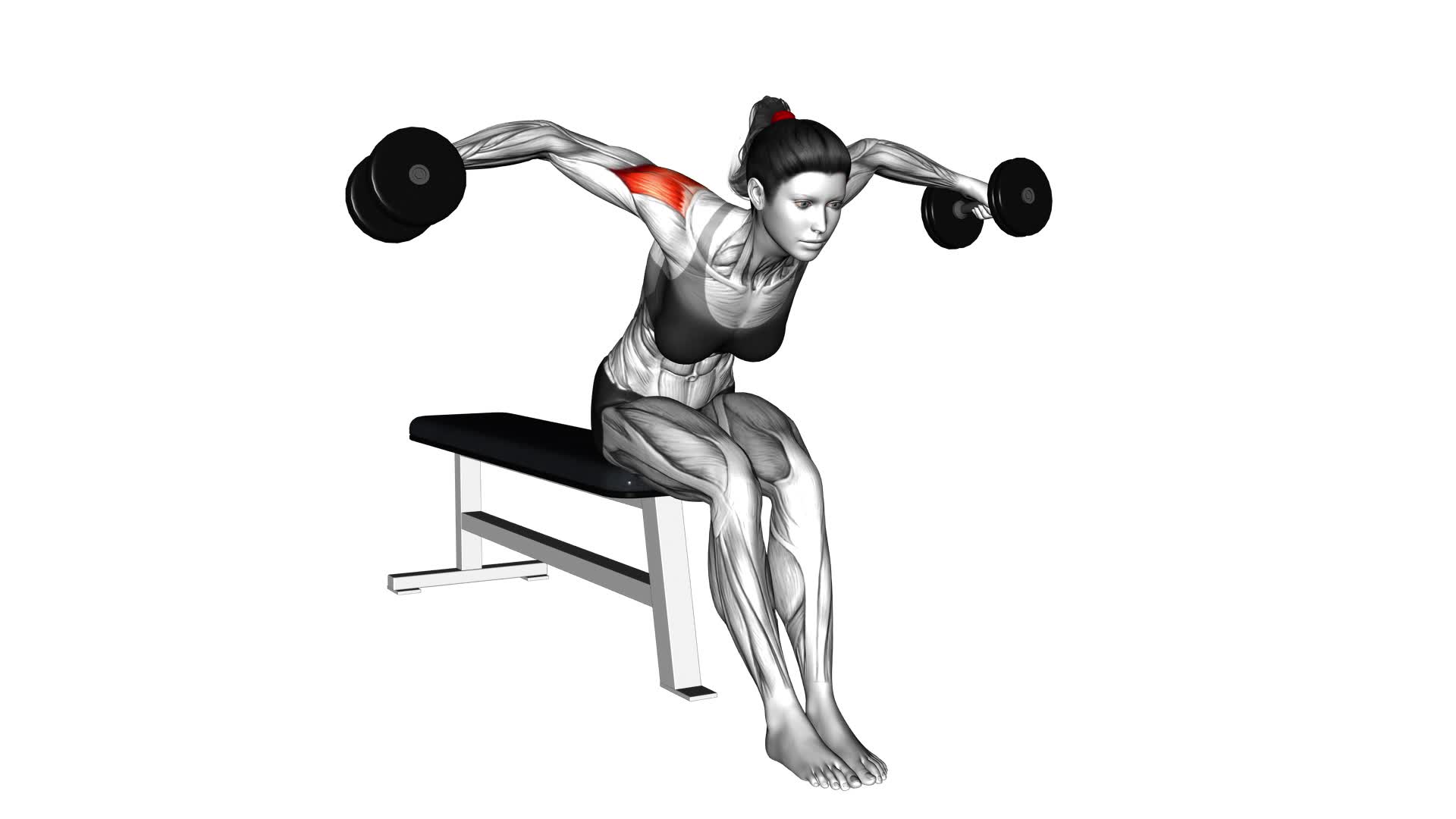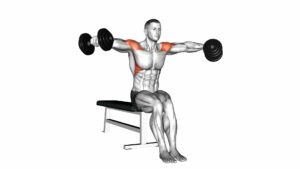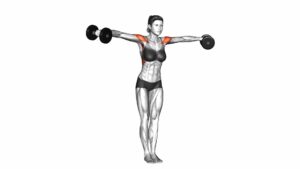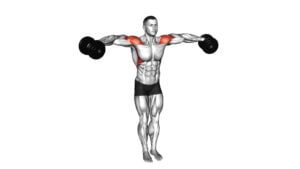Dumbbell Seated Bent Arm Lateral Raise (female) – Video Exercise Guide & Tips

In this video exercise guide, you'll learn all about the dumbbell seated bent arm lateral raise.
Watch This Exercise Video
This exercise is specifically designed for females looking to tone and strengthen their upper body.
You'll discover the benefits of this particular move, proper form and technique, as well as variations for different fitness levels.
We'll also cover common mistakes to avoid and provide tips to maximize the effectiveness of your workout.
Get ready to sculpt those arms with this informative and precise guide!
Key Takeaways
- Targets shoulder muscles for strength and toning
- Improves upper body strength and stability
- Enhances posture and shoulder stability, reducing the risk of injuries
- Engages other upper body muscles for a well-rounded workout
Benefits of the Dumbbell Seated Bent Arm Lateral Raise
The dumbbell seated bent arm lateral raise offers numerous benefits for you. This exercise primarily targets your shoulder muscles, helping to strengthen and tone them. By performing this exercise regularly, you can develop stronger and more defined shoulders, which not only enhances your overall physique but also improves your upper body strength and stability.
Additionally, the dumbbell seated bent arm lateral raise engages other muscles in your upper body, such as your trapezius and deltoids, providing a well-rounded workout for your upper body. This exercise can also help improve your posture and shoulder stability, reducing the risk of injuries and enhancing your overall functional fitness.
To reap the full benefits of this exercise, it's important to perform it with proper form and technique. By maintaining a seated position and keeping your arms bent at a slight angle, you can effectively target your shoulder muscles and minimize strain on your joints.
Now, let's delve into the proper form and technique for the dumbbell seated bent arm lateral raise.
Proper Form and Technique for the Exercise
To perform the dumbbell seated bent arm lateral raise with proper form and technique, start by sitting on a bench or chair with your feet flat on the ground and a dumbbell in each hand. Keep your back straight and engage your core muscles. Begin with your arms hanging down by your sides, palms facing your body.
As you raise the dumbbells, bend your elbows slightly and lift them out to the sides until they're at shoulder level. Keep your elbows in a fixed position throughout the movement. Pause for a moment at the top of the movement, then slowly lower the dumbbells back to the starting position.
To ensure proper form and technique, it's important to avoid common mistakes. One common mistake is using excessive momentum to lift the dumbbells, which can compromise the effectiveness of the exercise. Another mistake is lifting the dumbbells too high, which can lead to shoulder strain. It's important to maintain control throughout the movement and focus on using your shoulder muscles to lift the weight.
To maximize the effectiveness of the dumbbell seated bent arm lateral raise, here are some tips. Firstly, use a weight that challenges you but still allows you to maintain proper form. Secondly, perform the exercise in a slow and controlled manner, focusing on the contraction of your shoulder muscles. Lastly, make sure to breathe properly throughout the exercise, exhaling as you lift the dumbbells and inhaling as you lower them.
Now that you have learned the proper form and technique for the dumbbell seated bent arm lateral raise, let's move on to the next section about the recommended dumbbell weight for beginners.
Recommended Dumbbell Weight for Beginners
For beginners, a recommended dumbbell weight for the dumbbell seated bent arm lateral raise is the next step in your progression. Dumbbell weight selection is an important aspect of any exercise routine, as it determines the level of resistance you'll be working against.
When starting out, it's essential to choose a weight that challenges you but allows you to maintain proper form throughout the exercise. As a general guideline, beginners should start with a weight that allows them to perform 10-12 repetitions with good technique. This weight should feel challenging but not overly difficult.
As you become more comfortable and stronger, you can gradually increase the weight to continue progressing. It's important to have a progression plan in place to prevent plateauing and keep challenging your muscles. This can involve gradually increasing the weight or incorporating variations and modifications to make the exercise more challenging.
Transitioning into the subsequent section about variations and modifications for different fitness levels, let's explore how you can continue to challenge yourself and make progress as you become more experienced.
Variations and Modifications for Different Fitness Levels
To continue challenging yourself and making progress as you become more experienced, regularly incorporate variations and modifications into your dumbbell seated bent arm lateral raise routine. Here are some options to consider:
- Exercise modifications for shoulder injuries: If you have a shoulder injury or discomfort, you can modify the exercise by using lighter weights or resistance bands. Instead of raising your arms to the side, you can try a front raise or an upright row to target the deltoids without putting as much strain on your shoulders.
- Progression options for advanced fitness levels: Once you have mastered the basic seated bent arm lateral raise, you can make the exercise more challenging by using heavier dumbbells or increasing the number of repetitions. Another option is to perform the exercise while standing instead of sitting, which engages your core and adds a stability component to the movement.
- Tempo variations: To add variety to your routine, you can experiment with different tempos. Slow down the movement by taking 3-4 seconds to raise the dumbbells and 3-4 seconds to lower them. This will increase the time under tension and make the exercise more challenging.
- Superset with other exercises: To further enhance your shoulder workout, you can incorporate supersets. Pair the seated bent arm lateral raise with exercises like overhead presses or front raises to work different parts of the shoulder and increase the overall intensity of your workout.
Common Mistakes to Avoid During the Exercise
Avoid these common mistakes during the dumbbell seated bent arm lateral raise exercise to maximize its effectiveness and prevent injury. Proper form is crucial for getting the most out of this exercise.
One common mistake is using too much weight. It's important to start with a weight that allows you to maintain proper form throughout the movement. Using weights that are too heavy can lead to swinging or jerking motions, which can put strain on your shoulder and decrease the effectiveness of the exercise.
Another mistake to avoid is lifting your shoulders. Keep your shoulders relaxed and down throughout the movement. Lifting your shoulders can take the focus away from your lateral deltoids and shift it onto other muscles, such as your traps. To ensure proper form, imagine sliding your shoulder blades down your back as you lift the weights.
It's also important to maintain a slight bend in your elbows throughout the exercise. Straightening your arms completely can put unnecessary strain on your joints. By keeping a slight bend, you engage your deltoids more effectively and reduce the risk of injury.
Lastly, make sure to avoid using momentum to lift the weights. This can be done by controlling the movement and lifting the weights in a slow and controlled manner. Using momentum takes away from the effectiveness of the exercise and increases the risk of injury.
Tips for Maximizing the Effectiveness of the Dumbbell Seated Bent Arm Lateral Raise
To enhance the effectiveness of the dumbbell seated bent arm lateral raise, focus on these key tips:
- Use proper form:
- Maintain a seated position with your feet flat on the floor and your back straight against a bench.
- Hold the dumbbells with your palms facing inward and your elbows bent at a 90-degree angle.
- As you raise your arms out to the sides, keep your elbows slightly bent and avoid swinging or using momentum.
- Engage your shoulder muscles:
- Focus on isolating your shoulder muscles during the exercise.
- Imagine squeezing your shoulder blades together as you lift the dumbbells.
- Consciously contract your deltoids throughout the movement.
- This will ensure that your shoulder muscles are doing the majority of the work, maximizing results.
- Increase weight gradually:
- As you become stronger, gradually increase the weight of the dumbbells.
- This will continue challenging your shoulder muscles.
- However, be careful not to sacrifice form for heavier weights.
- It's better to perform the exercise with proper technique using lighter weights than to use heavy weights with incorrect form.
- Control the descent:
- The eccentric, or lowering, phase of the exercise is just as important as the concentric, or lifting, phase.
- Slowly and controlledly lower the dumbbells back down to the starting position.
- Focus on maintaining tension in your shoulder muscles.
- This will further improve shoulder strength and maximize the effectiveness of the exercise.
Frequently Asked Questions
How Many Reps and Sets Should I Do for the Dumbbell Seated Bent Arm Lateral Raise?
For the dumbbell seated bent arm lateral raise, it's recommended to do 3 sets of 12-15 reps.
Start with a weight that challenges you but allows you to maintain proper form throughout the exercise.
Keep your back straight, engage your core, and focus on lifting the dumbbells out to the sides with a slight bend in your elbows.
Can I Do This Exercise if I Have Shoulder Pain or Injury?
If you have shoulder pain or injury, it's important to modify your exercises to avoid worsening the condition.
There are alternative exercises for shoulder pain that you can do instead of the Dumbbell Seated Bent Arm Lateral Raise.
It's best to consult with a healthcare professional or a certified trainer who can provide you with specific modifications and exercises that are suitable for your condition.
Is It Better to Use Lighter Weights With More Reps or Heavier Weights With Fewer Reps for This Exercise?
When it comes to the Dumbbell Seated Bent Arm Lateral Raise, the choice between lighter weights with more reps or heavier weights with fewer reps depends on your goals.
If you're aiming for muscle growth, using heavier weights with fewer reps is generally more effective. This helps to stimulate muscle fibers and promote strength gains.
However, lighter weights with more reps can still be beneficial for endurance and toning.
It's important to find the optimal rep range that works for you and your specific goals.
Can I Perform the Dumbbell Seated Bent Arm Lateral Raise Standing Instead of Seated?
You're wondering if you can do the dumbbell seated bent arm lateral raise while standing instead of sitting.
While the exercise is typically performed in a seated position, you can definitely try doing it standing if you prefer.
Keep in mind that the seated position provides better stability and isolation of the targeted muscles.
However, standing can engage more of your core muscles for additional balance and stability challenges.
Experiment with both positions and see which one works best for you.
Will This Exercise Help in Toning My Triceps as Well?
Yes, the dumbbell seated bent arm lateral raise can help in toning your triceps.
This exercise specifically targets the lateral head of your triceps muscle, which is responsible for the overall definition and tone of your upper arms.
If you're looking for alternatives for triceps toning, you can also try exercises like triceps pushdowns, triceps dips, and diamond push-ups, which all effectively target and tone the triceps muscles.
Conclusion
In conclusion, the dumbbell seated bent arm lateral raise is a highly effective exercise for targeting and strengthening the shoulder muscles. By following proper form and technique, beginners can start with lighter dumbbell weights and gradually progress to heavier ones.
Modifications and variations can be made to accommodate different fitness levels. It's important to avoid common mistakes and maximize the effectiveness of the exercise by staying focused and engaging the targeted muscles.
Incorporating this exercise into your routine can help improve shoulder strength and stability.

Author
Years ago, the spark of my life’s passion ignited in my mind the moment I stepped into the local gym for the first time. The inaugural bead of perspiration, the initial endeavor, the very first surge of endorphins, and a sense of pride that washed over me post-workout marked the beginning of my deep-seated interest in strength sports, fitness, and sports nutrition. This very curiosity blossomed rapidly into a profound fascination, propelling me to earn a Master’s degree in Physical Education from the Academy of Physical Education in Krakow, followed by a Sports Manager diploma from the Jagiellonian University. My journey of growth led me to gain more specialized qualifications, such as being a certified personal trainer with a focus on sports dietetics, a lifeguard, and an instructor for wellness and corrective gymnastics. Theoretical knowledge paired seamlessly with practical experience, reinforcing my belief that the transformation of individuals under my guidance was also a reflection of my personal growth. This belief holds true even today. Each day, I strive to push the boundaries and explore new realms. These realms gently elevate me to greater heights. The unique combination of passion for my field and the continuous quest for growth fuels my drive to break new ground.







